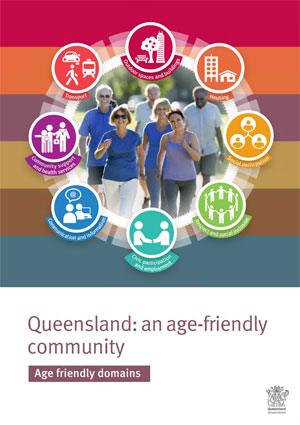What is age-friendly
Age-friendly is an approach developed by the World Health Organization (WHO) featuring 8 key action areas that directly influence the quality of life and wellbeing of older people, including:
- Outdoor spaces and buildings
Seniors live in an environment that includes open spaces, buildings, shaded areas and walkways that are safe and easy to navigate. - Transport
Seniors can get out and about using a range of affordable, user-friendly transport and associated services. - Housing
Seniors' housing options are affordable, accessible and close to transport and community services. - Social participation
Seniors are supported to be active in their community doing the things they enjoy. - Respect and social inclusion
Seniors from all backgrounds are valued and appreciated and no one is excluded based on race, geography, culture, language, gender, sexuality, ability or socioeconomic status. - Civic participation and employment
Seniors participate in employment, training, lifelong learning and volunteering opportunities and inform government policies. - Communication and information
Seniors access information they need in a variety of formats to stay informed and connected with their communities, families and friends. - Community support and health services
Seniors are helped to stay healthy, active and independent through community support and health services, including services responding to elder abuse, fraud or exploitation.
Read the Queensland: an age-friendly community age friendly domains Queensland: an age-friendly community age friendly domains guide for more information.
What is an age-friendly community?
An age-friendly community is one that enables people of all ages to actively participate in community life by ensuring older people are free from age-related barriers that prevent participation and engagement.
Key features include:
- pleasant, secure and physically accessible outdoor spaces and public buildings
- well-designed, affordable and secure housing choices
- well-maintained and accessible roads and walkways
- affordable and accessible public transport
- secure neighbourhoods
- respectful relationships
- supportive health and community services
- opportunities to be socially active
- opportunities to participate in suitable volunteer, civic and employed positions
- information that is easy to access and understand.
What does age-friendly look like?
Age-friendly in the community
CURA runs weekly health and wellness events for its members in the Gold Coast region. They have an age-friendly facility with easy access and a shuttle bus that picks members up from their home.
The elderly Japanese community wanted exercise that was different to a regular western-style class. Culturally, the group was more used to sitting on the floor and so had more physical flexibility. CURA designed a weekly health activity for them, run by its in-house physio with the aid of a Japanese translator. Having seen the great success of this program, CURA has added more culturally influenced activities such as different kinds of dancing for different communities. This is a great example of taking cultural backgrounds and lifestyles into account when designing activities for older people.
Dementia-friendly
The number of people with dementia in Queensland is expected to increase 5.5 times by 2050. This increase has contributed to calls by Alzheimer’s Australia for the development of dementia-friendly communities.
Given that dementia is primarily a disease of older people, organisations could consider incorporating principles of dementia-friendly communities into their age-friendly strategy.
Useful resources on dementia-friendly communities include:
- A guide to becoming a dementia-friendly community
- Creating dementia-friendly communities: business toolkit
- Creating dementia-friendly communities: A toolkit for local government
The Queensland Government’s approach to an age-friendly state
The Queensland Government’s strategic direction statement Queensland: an age-friendly community Queensland: an age-friendly community presents the goal for Queensland to build an age-friendly state in which all Queenslanders, regardless of their age, can stay active and connected, and contribute economically, socially, and culturally.
The Queensland Government has set goals for each of the WHO 8 domains and has developed an Action plan Action plan that outlines a range of age-friendly initiatives and services across the state.
Additional links and resources
- Last reviewed
- 4 August 2023
- Last modified
- 4 August 2023
 This work is licensed under a Creative Commons Attribution 4.0 International (CC BY 4.0) licence
This work is licensed under a Creative Commons Attribution 4.0 International (CC BY 4.0) licence






